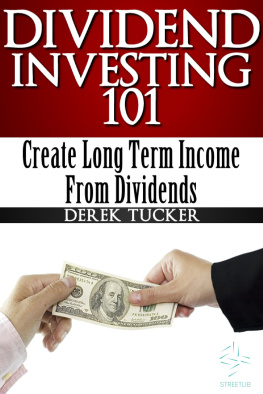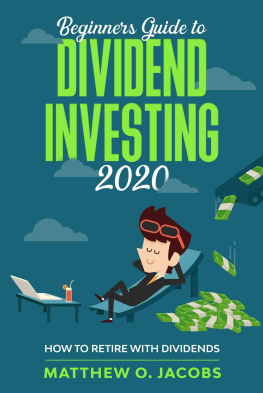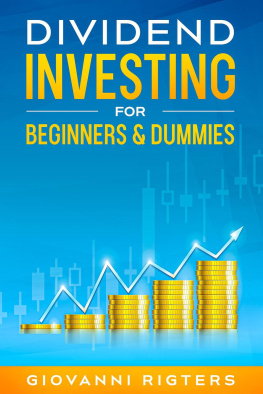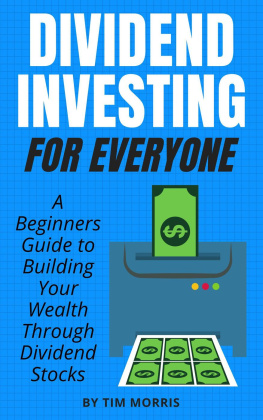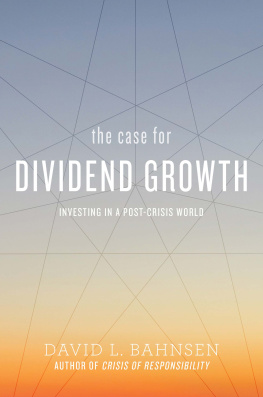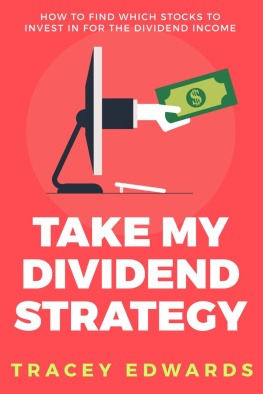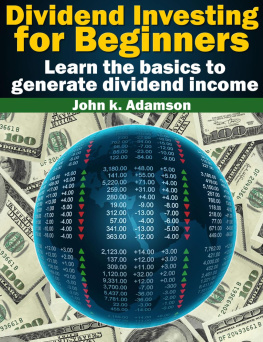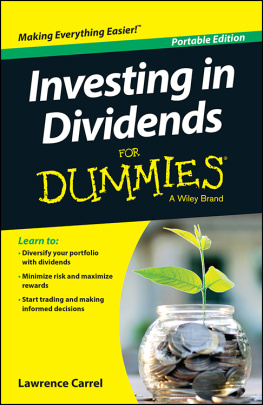Derek Tucker
Dividend Investing 101 : Create Long Term Income from Dividends
Dividend Investing 101 Create Long Term Income from Dividends
Copyright 2012 Derek Tucker. All Rights Reserved.
Disclaimer: This book contains information regarding general personal finance that is based on author's own knowledge and experiences. It is published for general reference and is not intended to be a substitute for independent verification by a professional financial planner or accountant. The publisher and the author disclaim any personal liability, either directly or indirectly, for the information contained within. Although the author and the publisher have made every effort to ensure the accuracy and completeness of the information contained within, we assume no responsibility of errors, inaccuracies, omissions and inconsistencies.
Many times, when investors think about investing, they typically think about stocks preferably ones that will grow in value and make them a neat packet of money. But the fact is, when it comes to making money, pure growth stocks aren't the only option. Dividend stocks can be a lucrative alternative.
The key lies in making sure you pick the right stocks to make a good dividend income.
Here are some truths about dividends that will help you make an informed decision about dividend investing.
Bill Gates owns $660.9 million MSFT shares. Just from dividends on his MSFT stock, that amounts to $343.7 million a year in income. So if you had invested $1,000 in MSFT stock when they did their IPO, you would now own 13,708 shares, amounting to .36 million and the dividends you would have earned annually add up to $8,778. That is great given that you only invested $1,000 initially and nothing more. Now this could have been more, as traditionally MSFT is not known to pay dividends consistently, as they prefer to sit on a pile of cash.
If you are worried that companies will stop paying dividends based on the economy or on market conditions, then let me assure you that there are plenty of companies in America that have a dividend history going back 50-60 years or even more.
For example, the company that manufactures Big G cereals and Betty Crocker Desserts goes by the name of General Mills. They have paid dividends for the last hold your breath 113 years. In fact, in the last five years which you will agree was a very tough period, they have increased their dividend payout at 11% compounded annually.
Still not confident about dividends? Then hear this. PepsiCo, Inc., has paid dividend to its investors since 1952. For 40 consecutive years they have increased their dividends. That is quite some record, and I am sure they have their share of troubles and bad economic conditions. However, a lot of companies view dividends as value creation, and that is what keeps them going.
Read on to learn about dividend investing and what it takes to generate a good dividend income. I will detail what it takes to build a good dividend income portfolio. We will delve into dividend investing strategies and the common mistakes to avoid.
Happy reading and earning. Let's dive straight in see what we can do to give you a nice long-term income from stocks. You will learn all about dividends, the tax strategy that you need to follow, and how to calculate the yield from dividends (called dividend yield).
In this book I will cover the following topics:
Basics of Dividend Investing
How to Pick Dividend Stocks
Two Important Ratios for Selecting Dividend Stocks
What Are Dividend Aristocrats?
Dividend Reinvestment Plans
Dividend ETFs
Top Ten List
Chapter 1: Back to Basics What Is Dividend Investing?
Let's first look at the basics of dividends. In simple language, when a company makes a profit from its business, it can use that money in a variety of ways. These ways typically include paying out the money to shareholders, and this is known as dividend. The other way to use the profit is to reinvest the money to buy another company, or to start another business related to core business, or even look at capacity expansion, etc. In simple words, either it is pay out dividends, or reinvest the money.
A lot of companies do not pay any dividends and prefer to either reinvest or accumulate cash and wait for a big business acquisition. Apple and Microsoft did not pay any dividends for a long, long time.
What is dividend investing? Dividend investing simply means investing in stocks that pay dividends consistently, which will augment your income. If you are new to dividends, then you need to know these important dates.
Ex-div date This is the date when the people on the record as shareholders will become eligible to receive dividends. For example, if you bought a stock on July 5, and July 2 was the ex-div date, then you will not be entitled to the dividends. The previous owner of the shares will get the dividends.
Payment date As the name suggests, it is the date when the dividends are paid. Of course these will be paid to those shareholders who hold the stocks on the ex-div date. Also, every company has a different interval for paying dividends. Some pay annually and some pay quarterly.
Types of Dividends
In most cases you will have no control over what type and how much dividend income you get; however, it still is better to know the various types of dividends that the companies pay. The two primary types are:
Cash dividends: The company will pay a part of the profit that they make as cash dividends. For example, typically the announcement will say that Company ABC has decided to pay a dividend of 90 cents per share. That is a pure cash dividend, which means they would pay an annual amount of 90 cents for each share you hold for Company ABC. If the company pays the dividend quarterly, then it will pay a dividend of 22.5 cents each quarter for each share you hold.
Stock dividends: Rather than paying a cash dividend, a company can decide to pay shares as dividends. For example, Company ABC might declare it will pay a 5% stock dividend. This will mean that if you hold 100 shares of Company ABC stock, then you will get an additional 5 shares. Now, this may have its negatives if you prefer a cash dividend. Also, the company may have its own reason to not declare cash dividends, such as to save the cash for future investments.
Dividend reinvestment You will hear this term more often once you are into dividend investing. We will deal with this topic later; for now it is important to know that companies may give you an option to reinvest your entire cash dividend, or some part of it, to buy additional shares of the company. However, for reinvesting you need to be part of some sort of dedicated reinvestment plan for that company. This will be discussed in later chapters.
One time dividends One time dividends, or special dividends, as the name suggests, are unique dividends which are paid out just once for a special reason. If you are looking at long term dividend investing, you should not be relying on one-time dividends to generate income.
Chapter 2: Two Ratios That You Cannot Afford to Ignore Dividend Yield and Dividend Payout Ratio
The most important ratio that will help you build a good dividend portfolio is dividend yield; another important ratio is dividend payout ratio.

